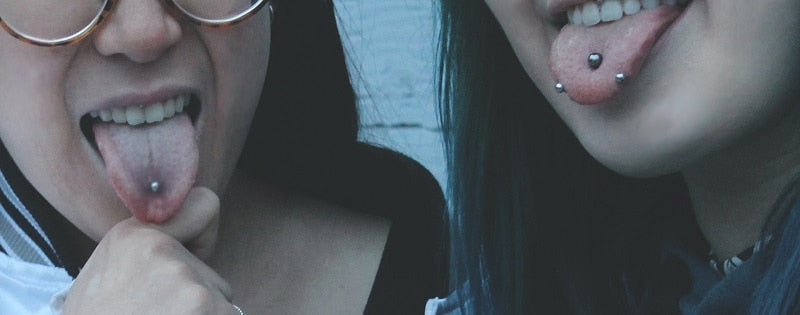
Many of our piercing artists in both Toronto & Vancouver and Markham have noticed a lot of confusion around dermal piercings of late. As these kinds of piercings are quite different than what you might expect from a regular piercing, we wanted to take the time to explain how a dermal piercing differs from a regular piercing and how it can often be a much more effective choice for a piercing.
There’s more than one type of piercing?
Before we dive into what dermals are, let’s start with what is often defined as a “regular” or “surface” piercing. Surface piercings involve passing a bar or flexible piece of plastic through two, close together, points of skin.
The best way to visualize this is with a pen and some paper. Imagine the paper as your skin; now punch a hole through it with the pen and then another so that the front and back of the pen are now on the same side of the paper. This is a surface piercing. Jewellery is then attached to each end of the bar however, only specialized jewellery can do this.
As a result of this technique, surface piercings can put a lot of strain on your skin, in fact, the average lifetime of a surface piercing is only ~1-2 years before your body begins to
reject the piercing. Rejection is when your body begins pushing the piercing towards to surface, which can result in the piercing migrating or coming out completely; this is a similar process to how your body pushes out a splinter.
Surface piercings also have a number of other limitations including:
Flat Surfaces: Surface piercings are most effective when used on curved portions of your body, as it puts less strain on the individual openings (think back to the pen and paper example). Attempting to have a surface piercing done on a flat surface can result in increased strain on your skin and eventual rejection of the piercing.
Healing Time: As surface piercings put a lot of strain on your body, they often take longer to heal, often taking up to
3 months of aftercare before jewellery can be used.
What about Dermal Piercings?
Dermal piercings are comprised of two parts: the anchor and the piercing and each piercing is effectively “single point”. This means that you do not need a bar embedded in your skin connecting two points, you can have as many or as little dermal piercings as you’d like as they are completely independent of each other.
This makes dermal piercings extremely versatile as they can be placed almost anywhere on your body!
What about the pain? Aftercare?
As dermal piercings are single point, getting one actually involves a lot less strain being placed on your body. This means, less inflammation and pressure, which often results in a less painful procedure and a much shorter and safer aftercare period.
Of course, a dermal piercing can still be rejected by your body, but the likelihood of this occurring is less than that of a surface piercing as the implant has a much smaller presence in your body than the bars found in surface piercings.
When should I consider a Dermal Piercing?
If you’ve experienced difficulties with past piercings, whether they be from rejection, long healing times or general pain, then it may be time to consider a dermal piercing, but when you’re looking for a dermal piercing in Toronto & Vancouver, keep in mind the following points:
Cost: A proper dermal piercings requires a lot more experience and equipment than a standard piercing. As a result, they typically cost more than surface piercings.
Jewellery cost: As dermal piercings can last much longer, the quality of jewellery used needs to be high. For this reason, we tend to use high grade titanium in the base so that it will last as long as you need.
Maintenance: Although they often heal faster and last longer than surface piercings, dermal piercings still require proper care on an ongoing basis. Like other piercings, they are prone to damage and tearing if the wearer is not careful.
Consultation: Everyone’s body is different and what kind of piercing is best for you should be decided with a skilled piercing artist offering their input. If you’re considering a piercing, make sure that you listen to your artist’s recommendations as they will have the best feedback on what kind of piercing your body will be able to support.
If you’re interested in learning more about dermal piercings are the right fit for you, then feel free to
send us a message or come in for a consultation.

 Many of our piercing artists in both Toronto & Vancouver and Markham have noticed a lot of confusion around dermal piercings of late. As these kinds of piercings are quite different than what you might expect from a regular piercing, we wanted to take the time to explain how a dermal piercing differs from a regular piercing and how it can often be a much more effective choice for a piercing.
Many of our piercing artists in both Toronto & Vancouver and Markham have noticed a lot of confusion around dermal piercings of late. As these kinds of piercings are quite different than what you might expect from a regular piercing, we wanted to take the time to explain how a dermal piercing differs from a regular piercing and how it can often be a much more effective choice for a piercing.



